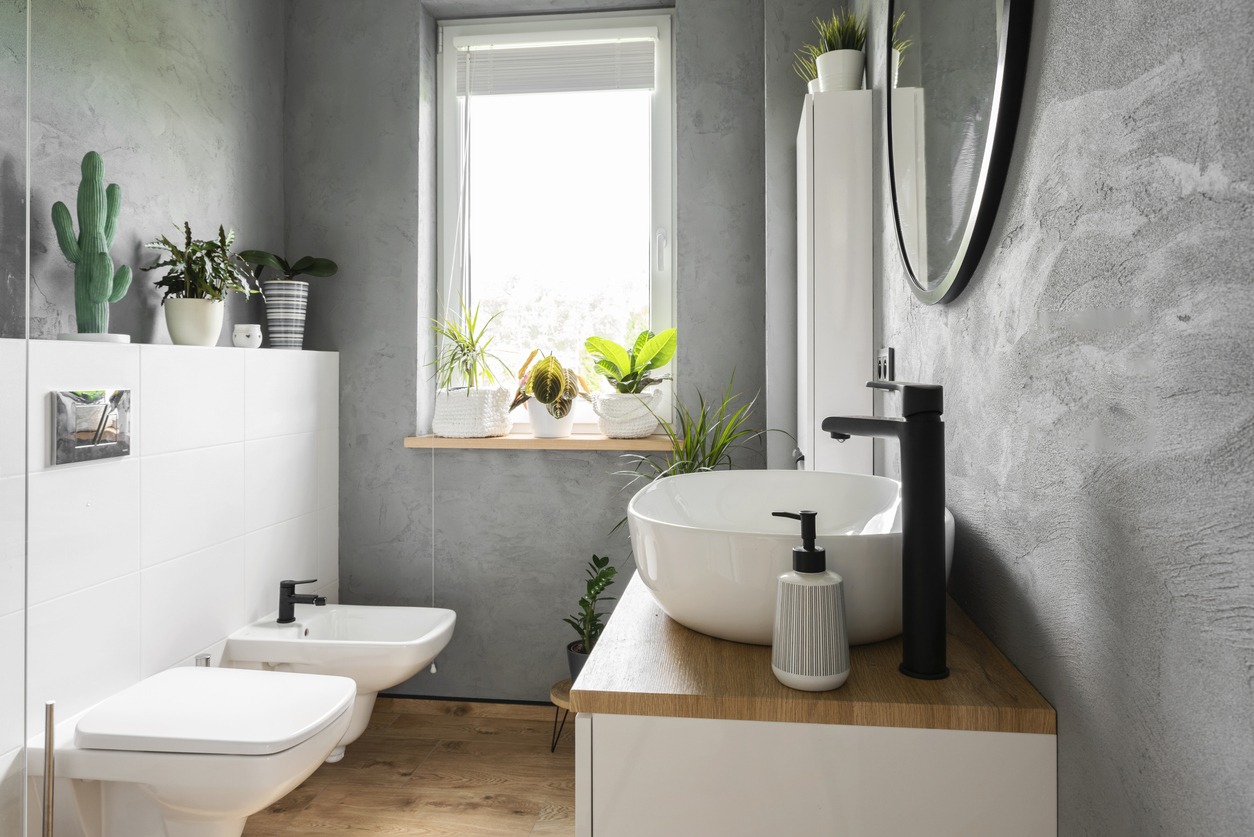Can you apply one type of interior paint finish for every room in your home? While it is ideal on paper, conditions in one room may not be the same in another room. Your bedroom is not the same as your kitchen, and your living room is not the same as your bathroom.
That’s why this article’s purpose is to address the misconception that uniform paint finishes are necessary for home interiors. It explores whether using the same paint finish in all interior rooms is needed or advantageous. The article will also highlight factors influencing paint finish choices, such as room function, lighting, and personal preference.
Understanding Paint Finishes
A paint finish refers to a painted surface’s final appearance and texture once the paint has dried. Different finishes have distinct characteristics that affect the paint’s look, feel, and durability. The main types of paint finishes include:
- Flat or matte: This finish has no sheen and a non-reflective surface. It is good at hiding imperfections but can be harder to clean.
- Eggshell: Slightly more sheen than flat, it has a soft, velvety appearance. It is easier to clean and more durable than flat finishes.
- Satin: This finish offers a smooth, silky look with a bit more sheen than eggshell. Due to its durability and ease of cleaning, it is commonly used in areas with moderate traffic and moisture, like bathrooms and kitchens.
- Semi-gloss: Has a noticeable sheen and is very durable. It’s often used for trim, doors, and high-traffic areas as it is easy to clean and moisture-resistant.
- Gloss: The shiniest finish, it provides a high level of reflection and is very durable. It is used for high-impact areas and is a great option when you need to refinish existing, cabinets, and furniture.
- High-gloss: The most reflective and durable of all finishes. It is used for surfaces and details that need a brilliant, shiny appearance.
The characteristics of each paint finish
Here are the detailed characteristics of each paint finish regarding durability, washability, and light reflection:
1. Flat or matte
- Durability: Low. This finish is less resistant to scratches and scuffs and may show marks more easily.
- Washability: Low. It is not very washable and can be difficult to clean without damaging the surface.
- Light Reflection: None. It has a non-reflective surface, which helps to hide imperfections on the wall.
2. Eggshell
- Durability: Moderate. It is significantly more durable than eggshell and can handle more frequent cleaning and higher traffic areas.
- Washability: Moderate. It is easier to clean than flat finishes yet requires careful handling to avoid damage.
- Light Reflection: Low. It has a soft, velvety appearance with minimal sheen.
3. Satin
- Durability: High. It is quite durable and can handle more frequent cleaning and higher traffic areas.
- Washability: High. This finish is easy to clean and suitable for areas requiring regular cleaning.
- Light Reflection: Moderate. It has a smooth, silky appearance with a noticeable sheen that reflects some light.
4. Semi-gloss
- Durability: Very High. This finish is highly durable and moisture-resistant, suitable for high-humidity areas.
- Washability: Very High. It is easy to clean and can handle frequent washing without losing its sheen.
- Light Reflection: High. It has a noticeable sheen that reflects a significant amount of light, highlighting surface imperfections, if any.
5. Gloss
- Durability: Extremely High. Gloss finishes are very durable and can withstand heavy use and frequent cleaning.
- Washability: Extremely High. This finish is painlessly easy to clean and ideal for surfaces needing regular washing.
- Light reflection: Very High. It provides a high level of reflection, giving surfaces a bright, shiny appearance.
6. High-gloss
- Durability: Exceptionally High. It is the most durable finish, resistant to scratches, scuffs, and general wear and tear.
- Washability: Exceptionally High. It is the easiest to clean and maintain among all other finishes, even with frequent washing.
- Light reflection: Extremely High. It is the most reflective, giving a brilliant, shiny appearance that can highlight imperfections.
Always remember that paint finishes with higher gloss are more durable and washable. However, glossier paints are also apt to reflect more light, potentially highlighting surface imperfections.
The choice of paint finish can affect a painted surface’s aesthetic appeal and practical functionality.
Factors to consider
When choosing a paint finish, consider the following factors:
- Functionality of the Room:
- High-traffic areas: For spaces like hallways and kitchens, opt for durable finishes such as satin or semi-gloss, which are easier to clean and more resistant to wear and tear.
- Low-traffic areas: Bedrooms and other less frequented spaces can benefit from matte or eggshell finishes, which provide a softer look.
- Aesthetic preferences:
- Desired Look and Feel: Choose a finish that aligns with the room’s ambiance. Glossy finishes reflect more light and can make spaces feel more vibrant, while matte finishes offer a more subdued and sophisticated appearance.
- Cohesiveness vs. contrast: Decide if you want the paint finish to blend seamlessly with existing decor or create a striking contrast to highlight particular areas.
- Lighting conditions:
- Natural light: Rooms with ample natural light can handle matte finishes better, as they reduce glare.
- Artificial lighting: In spaces primarily lit by artificial light, glossier finishes can help brighten the room by reflecting light.
Pros and cons of using the same finish
Pros:
- Consistency and flow:
- Creates a cohesive and harmonious look throughout the space.
- Ensures a seamless transition between rooms, enhancing the overall aesthetic.
- Simplicity in selection and purchasing:
- Simplifies the decision-making process, reducing the time and effort spent choosing different finishes.
- It is easier to manage inventory and costs, as fewer types of paint need to be purchased and stored.
Cons:
- Lack of customization:
- Limits the ability to tailor the appearance of each room to its specific purpose or mood.
- Reduces opportunities to highlight architectural features or create visual interest with different finishes.
- Potential mismatch in functionality needs:
- Some areas, like kitchens and bathrooms, may require more durable, moisture-resistant finishes than living rooms or bedrooms.
- Using the same finish throughout might not provide the necessary durability or ease of cleaning in high-traffic or high-moisture areas.
When to mix and match paint finishes?
There are circumstances where you can mix and match paint finishes. Look at the following scenarios, strategies, and examples:
Practical scenarios
- Bathrooms and kitchens (high moisture areas):
- Use semi-gloss or gloss finishes for durability and easy cleaning.
- Living rooms and bedrooms (aesthetic choices):
- Use flat or matte finishes for a sophisticated look and to hide imperfections.
- Use eggshell or satin finishes for a balance between aesthetic appeal and durability.
Design strategies
- Accent walls:
- Use a different finish (e.g., satin or semi-gloss) to create a focal point and add visual interest.
- Architectural features (trim and molding):
- Use a higher gloss finish to make these features stand out against walls with a matte or eggshell finish.
Examples and case studies
- Example 1
In a modern bathroom, semi-gloss paint was used on walls to combat moisture, while the ceiling was painted with a matte finish for a sleek look. - Example 2
In a traditional living room, flat paint was applied to walls for a smooth appearance, with glossy paint on crown molding and trim to highlight architectural details.
Expert opinions
Design experts have various opinions about the best paint finish to use in the different rooms of a house. Below are general guidelines for interior spaces:
Interior designers
Interior designers often recommend varying paint finishes based on each room’s function and aesthetic goals. For instance, flat or matte finishes are favored for low-traffic areas like bedrooms and ceilings due to their ability to hide imperfections and provide a sophisticated look. However, these finishes are less durable and more challenging to clean, making them less suitable for high-traffic areas or spaces prone to moisture.
Satin and eggshell finishes are preferred in living areas due to their durability, sheen, and ease of maintenance.
Semi-gloss and high-gloss finishes are durable and easy to clean, making them ideal for high-traffic areas, trim, and cabinetry. However, their reflective nature can magnify imperfections, requiring careful surface preparation. They are also ideal for moisture-prone areas like kitchens and bathrooms.
Paint specialists
Paint specialists recommend flat and matte finishes for ceilings and low-traffic areas due to their light-absorbing and imperfection-concealing properties. These finishes are also suitable for bedrooms seeking a tranquil, less reflective surface.
Specialists recommend eggshell or satin finishes in high-traffic areas for their durability, subtle sheen, and cleaning ease.
Semi-gloss and high-gloss finishes are ideal for moisture-prone areas like kitchens and bathrooms. They are durable, moisture-resistant, and easy to clean, perfect for surfaces needing frequent wiping.
Interior designers prioritize aesthetics and functionality, whereas paint specialists emphasize durability and maintenance benefits. These industry experts agree on matching paint finishes to room use and conditions.
Practical tips for homeowners
Consideration of room usage
Choose finishes based on the room’s usage. High-traffic areas like kitchens and bathrooms benefit from durable, easy-to-clean finishes like semi-gloss or satin. On the other hand, low-traffic areas like bedrooms can use matte or eggshell finishes for a softer look.
Balancing aesthetics and practicality
Match the finish to the desired aesthetic and practical needs. Glossy finishes are sleek and reflective but show imperfections, while matte finishes offer a subtle look but are harder to clean. Select finishes that enhance the room’s style while meeting maintenance needs.
Application techniques:
- Tips for a professional look:
- Prepare the surface correctly by cleaning, repairing flaws, and priming it.
- Use only high-quality paint brushes and rollers to ensure correct and smooth application.
- Apply paint in thin, even coats, allowing adequate drying time between layers.
- Common mistakes to avoid:
- Skipping surface preparation leads to poor adhesion.
- Overloading brushes or rollers with paint causes drips and uneven coverage.
- Ignoring drying times can result in streaks and a patchy finish.
Conclusion
Experimenting with and personalizing different paint finishes can transform any space, adding depth and character. Try various finishes like matte, eggshell, satin, or gloss to see how they interact with your lighting and decor. Trust your creativity and have fun with the process—your home should reflect your unique style.
If you’re still in doubt or need expert advice and assistance, turn to our qualified paint professionals at Custom Painting, Inc. Hiring us to apply the correct paint finishes to your home’s interiors saves you time and effort, ensures professional results, and provides peace of mind knowing we will do the job right. For questions or requests for a free estimate, call us at 925-294-8062 or message us in our contact form. We will be happy to hear from you!




